
Similar in construction to the previous 8"/55 (20.3 cm) Mark 14, but of much lighter construction and a smaller overall diameter.
These guns were used in two distinct mountings. The triple mounting used on the Tuscaloosa (CA-37) sub-class were similar to those used on their sisters of the New Orleans (CA-32) class, but these much lighter guns gave them a significantly lower revolving weight. The mountings on the Wichita (CA-45), Baltimore (CA-68) and Oregon City (CA-122) classes were greatly different from those for the previous heavy cruisers. The guns were individually sleeved and mounted further apart, allowing for better shell dispersion characteristics. The Baltimore and Oregon City classes also had different shell-handling equipment than did the older cruisers in order to use the new, "super-heavy" 335 lbs. (152 kg) AP projectile. The older cruisers continued to use the previous 260 lbs. (118 kg) AP projectile.
In 1970, USS St. Paul (CA-73), using Long Range Bombardment Ammunition (LRBA), made some of the longest gun-fire missions in history when she fired on Viet Cong targets some 35 miles away, destroying six structures. See sketch below.
Mark 12 had an autofretted A tube, shrunk on jacket, screw box liner, yoke ring in halves and used a down-swinging Welin breech block. The Mark 15 was similar but had a differently shaped chamber and rifling identical to the Mark 14. Both Marks had chromium-plated bores. The Mark 12 Mod 2 and Mark 15 Mod 1 had adapter sleeves which allowed them to replace the older 8"/55 (20.3 cm) guns.
| Designation | 8"/55 (20.3 cm) Marks 12 and 15 |
|---|---|
| Ship Class Used On | Mark 12: Tuscaloosa (CA-37) sub-class 1, Wichita (CA-45) and Baltimore (CA-68)
Mark 15: All other Baltimore class and Oregon City (CA-122) class Minneapolis (CA-36) was regunned with Mark 15 Mod 1 in 1945 |
| Date Of Design | 1933 |
| Date In Service | 1939 |
| Gun Weight | 17.11 - 17.17 tons (17.38 - 17.45 mt) |
| Gun Length oa | 449.0 in (11.405 m) |
| Bore Length | 440.1 in (11.179 m) |
| Rifling Length | 373.65 in (9.491 m) |
| Grooves | 64 (?) |
| Lands | N/A |
| Twist | Mark 12: Uniform RH 1 in 35
Mark 15: Uniform RH 1 in 25 |
| Chamber Volume | 4,860 in3 (79.6 dm3) |
| Rate Of Fire | 3 - 4 rounds per minute |
- ^The Tuscaloosa sub-class consisted of Tuscaloosa (CA-37), San Francisco (CA-38), Quincy (CA-39) and Vincennes (CA-44).
| Type | Bag |
|---|---|
| Projectile Types and Weights | AP Mark 21 Mods 1 to 5 (super heavy) 1a: 335 lbs. (152 kg)
AP Mark 19 Mods 1 to 6 2a: 260 lbs. (118 kg) SP Common Mark 17 Mods 1 to 4 3a: 260 lbs. (118 kg) HC Mark 24 Mods 1 to 5 4a: 260 lbs. (118 kg) HC Mark 25 Mod 1 4a 5a: 260 lbs. (118 kg) LLRB 6a: 111.8 lbs. (50.7 kg) |
| Bursting Charge | AP Mark 21: 5.03 lbs. (2.3 kg) Explosive D
AP Mark 19: 3.64 lbs. (1.7 kg) Explosive D SP Common: 10.38 lbs. (4.7 kg) Explosive D HC Mark 24: 21.34 lbs. (9.7 kg) Explosive D HC Mark 25: 21.37 lbs. (9.7 kg) Explosive D LLRB: 13 lbs. (5.9 kg) PBX-w-106 |
| Projectile Length | AP Mark 19: 36.0 in (91.4 cm)
AP Mark 21: 36.0 in (91.4 cm) SP Common: 36.0 in (91.4 cm) HC Mark 24: 34.56 in (87.8 cm) HC Mark 25: 34.61 in (87.9 cm) LLRB: 54 in (137.2 cm) |
| Propellant Charge 7a | Full Charge: 85 lbs. (38.6 kg) SPD
Full Flashless Charge: 89 lbs. (40.4 kg) SPCG Reduced Charge: 55 lbs. (24.9 kg) SPDN
|
| Muzzle Velocity | Full Charge: New Gun
AP Mark 21: 2,500 fps (762 mps) AP Mark 19: 2,700 fps (823 mps) SP Common: 2,700 fps (823 mps) HC: 2,700 fps (823 mps) LLRB: about 4,000 fps (1,200 mps) Reduced Charge: New Gun
|
| Working Pressure | 18.2 tons/in2 (2,870 kg/cm2) |
| Approximate Barrel Life | 715 rounds |
| Magazine capacity per gun | 150 rounds |
- ^AP Mark 21 (super heavy) was apparently issued only to the Baltimore (CA-68) and Oregon City (CA-122) classes.
- ^The Tuscaloosa (CA-37) sub-class and Wichita (CA-45) used the same AP Mark 19 as used for the older 8"/55 (20.3 cm) guns.
- ^SP Common had a thin cap and a windscreen.
- ^HC Mark 25 was designed such that it could be forged from the base end.
- ^In the late 1960s the "Gunfighter" program at Indian Head Naval Ordnance Station developed Long Range Bombardment Ammunition (LRBA) projectiles. These were Arrow Shells with a body diameter of 4.125" (10.4 cm) and a fin diameter of 5.0" (12.7 cm) which were sized to be fired from 8" (20.3 cm) guns by using a sabot and obturator system. Tests with these in 1968 showed maximum ranges of 72,000 yards (66,000 m). The burster in these shells was PBX-w-106, a castable explosive. Sabot weighed 17.6 lbs. (8.0 kg) and was discarded as the projectile left the muzzle. After a test firing off Okinawa of three inert-loaded shells, USS St. Paul (CA-73) in 1970 conducted a two day bombardment mission against Viet Cong positions at ranges up to 70,000 yards (64,000 m). At the time, St. Paul was the only 8" gunned cruiser still in active service.
- ^The propellant charges were in halves.
- Radius of ogive for both AP and HC rounds was 83 inches (211 cm) or about 10crh. Bourrelet diameter was 7.977 inches (20.3 cm).
| Elevation | Range | Angle of Fall | Time of Flight | Striking Velocity | Maximum Ordinate |
|---|---|---|---|---|---|
| 1.95 degrees | 4,000 yards (3,658 m) | 2.15 degrees | 5.17 seconds | 2,156 fps (657 mps) | 107 ft (33 m) |
| 5.81 degrees | 10,000 yards (9,140 m) | 7.52 degrees | 14.65 seconds | 1,248 fps (380 mps) | 862 ft (263 m) |
| 10.28 degrees | 15,000 yards (13,716 m) | 14.95 degrees | 24.70 seconds | 1,415 fps (431 mps) | 2,465 ft (751 m) |
| 16.45 degrees | 20,000 yards (18,290 m) | 25.73 degrees | 32.77 seconds | 1,248 fps (380 mps) | 5,650 ft (1,722 m) |
| 23.17 degrees | 24,000 yards (21,946 m) | 36.10 degrees | 49.56 seconds | 1,211 fps (369 mps) | 10,070 ft (3,069 m) |
| 40.72 degrees | 30,000 yards (27,430 m) | 54.45 degrees | 77.79 seconds | 1,294 fps (394 mps) | 24,770 ft (7,550 m) |
| 45.28 degrees | 30,500 yards (27,889 m) | 57.73 degrees | 84.15 seconds | 1,325 fps (404 mps) | 28,880 ft (8,803 m) |
- ^Values for AP Mark 21 from BuOrd OP 1100 and from "Naval Ordnance and Gunnery, Volume 2, Fire Control - 1950."
- ^This range table applies only to the Baltimore and Oregon City classes. Older cruisers were given the lighter AP Mark 19 (see AP Mark 19 range table below).
| Elevation | Range | Angle of Fall | Time of Flight | Striking Velocity | Maximum Ordinate |
|---|---|---|---|---|---|
| 1.71 degrees | 4,000 yards (3,658 m) | 1.92 degrees | 4.86 seconds | 2,267 fps (691 mps) | 95 ft (29 m) |
| 5.22 degrees | 10,000 yards (9,140 m) | 7.03 degrees | 14.03 seconds | 1,724 fps (525 mps) | 795 ft (242 m) |
| 10.55 degrees | 16,000 yards (14,630 m) | 16.80 degrees | 20.41 seconds | 1,340 fps (408 mps) | 2,834 ft (864 m) |
| 14.64 degrees | 20,000 yards (18,290 m) | 26.43 degrees | 36.91 seconds | 1,197 fps (365 mps) | 5,600 ft (1,707 m) |
| 22.40 degrees | 24,000 yards (21,946 m) | 37.43 degrees | 49.46 seconds | 1,165 fps (355 mps) | 10,130 ft (3,088 m) |
| 39.03 degrees | 30,000 yards (27,430 m) | 55.00 degrees | 76.88 seconds | 1,250 fps (381 mps) | 24,455 ft (7,454 m) |
| 41.92 degrees | 30,500 yards (27,889 m) | 57.25 degrees | 81.18 seconds | 1,268 fps (386 mps) | 26,950 ft (8,214 m) |
- ^Values for AP Mark 19, SP Common Mark 17 and Common Mark 15 from BuOrd OP 1188 page 30.
- ^This range table applies to the Tuscaloosa sub-class, Wichita and to Minneapolis after she was rearmed with Mark 15 guns during the war. It also applies to the Baltimore and Oregon City class cruisers for the SP Common Mark 17.
| Elevation | Range | Angle of Fall | Time of Flight | Striking Velocity | Maximum Ordinate |
|---|---|---|---|---|---|
| 1.70 degrees | 4,000 yards (3,658 m) | 1.90 degrees | 4.84 seconds | 2,273 fps (693 mps) | 94 ft (29 m) |
| 3.88 degrees | 8,000 yards (7,315 m) | 4.98 degrees | 10.68 seconds | 1,868 fps (569 mps) | 458 ft (140 m) |
| 5.23 degrees | 10,000 yards (9,144 m) | 7.20 degrees | 14.09 seconds | 1,686 fps (514 mps) | 799 ft (244 m) |
| 6.79 degrees | 12,000 yards (10,973 m) | 9.97 degrees | 17.90 seconds | 1,521 fps (463 mps) | 1,290 ft (393 m) |
| 10.75 degrees | 16,000 yards (14,630 m) | 17.83 degrees | 26.93 seconds | 1,376 fps (419 mps) | 2,926 ft (892 m) |
| 16.20 degrees | 20,000 yards (18,288 m) | 28.78 degrees | 38.13 seconds | 1,120 fps (341 mps) | 5,913 ft (1,802 m) |
| 19.62 degrees | 22,000 yards (20,117 m) | 34.82 degrees | 44.57 seconds | 1,107 fps (337 mps) | 8,136 ft (2,480 m) |
| 28.22 degrees | 26,000 yards (23,774 m) | 46.58 degrees | 59.52 seconds | 1,131 fps (345 mps) | 14,676 ft (4,473 m) |
| 42.10 degrees | 30,000 yards (27,432 m) | 58.77 degrees | 81.63 seconds | 1,203 fps (367 mps) | 27,227 ft (8,299 m) |
| 45.00 degrees | 30,360 yards (27,761 m) | 60.70 degrees | 85.92 seconds | 1,221 fps (372 mps) | 30,028 ft (9,153 m) |
| Range | Side Armor | Deck Armor |
|---|---|---|
| 10,800 yards (9,880 m) | 10.0" (254 mm) | --- |
| 15,400 yards (14,080 m) | 8.0" (203 mm) | --- |
| 18,400 yards (16,820 m) | --- | 2.0" (51 mm) |
| 20,800 yards (19,020 m) | 6.0" (152 mm) | --- |
| 23,800 yards (21,760 m) | --- | 3.0" (76 mm) |
| 24,400 yards (22,310 m) | 5.0" (127 mm) | --- |
| 27,600 yards (25,240 m) | --- | 4.0" (102 mm) |
| 28,600 yards (26,150 m) | 4.0" (102 mm) | --- |
- These figures are taken from armor penetration curves issued in 1942 as shown in "US Naval Weapons."
- This table applies only to the Baltimore and Oregon City classes. The Tuscaloosa and Wichita classes used the older 260 lbs. (118 kg) AP projectiles and would have had slightly less armor penetration characteristics as those listed for the 8"/55 (20.3 cm) Mark 14 as they had a lower MV.
| Designation | Triple Turrets
Tuscaloosa 1f 2f (3) Three-gun Turrets
|
|---|---|
| Weight 3f | Tuscaloosa: 250 tons (254 mt)
Wichita: 314 tons (319 mt) Baltimore and Oregon City: 303 tons (307.7 mt) |
| Elevation | -10 / +41 degrees |
| Elevation Rate | Tuscaloosa: 8 degrees per second
Wichita: 10.1 degrees per second Baltimore and Oregon City: 10.6 degrees per second |
| Train | about +150 / -150 degrees |
| Train Rate | Tuscaloosa: About 3 degrees per second
Others: 5.3 degrees per second |
| Gun recoil | 32 in (81 cm) |
| Loading angle | +9 degrees |
- ^The mountings on the Tuscaloosa sub-class resembled the earlier ones used on the New Orleans (CA-32) class with some dimensional and weight differences.
- ^It is possible that USS Quincy (CA-39) and USS Vincennes (CA-44) had further differences and "Naval Weapons of World War Two" speculates that the turret stool stiffeners were eliminated and that the barbettes were coined as in Wichita (CA-45), but they may have been the same as USS Tuscaloosa (CA-37).
- ^To save weight, the barbette design for the Wichita, Baltimore and Oregon City classes was in the shape of a truncated inverted cone.
- The Wichita, Baltimore and Oregon City classes had a 75 hp training motor. Each gun had a 15 hp elevation motor, a 15 hp ramming motor and a 10 hp shell hoist motor. Upper charge hoists on Baltimore and Oregon City were powered by six 2 hp motors and the lower hoists by three 25 hp motors. All motors drove hydraulic gear.
- The gun axes on Wichita, Baltimore and Oregon City were about 67 in (170 cm) apart.
- Each mounting requires a crew of about 66 to operate.
- As was typical of US designs of this period, guns could be removed and replaced without dismantling the gunhouse.
- USS Boston (CA-69) and USS Canberra (CA-70) traded their stern 8"/55 (20.3 cm) mounting for two twin Terrier missile launchers in the 1950s. USS Albany (CA-123), USS Chicago (CA-136) and USS Columbus (CA-74) had all of their gun armament removed and were rebuilt into all-missile cruisers.
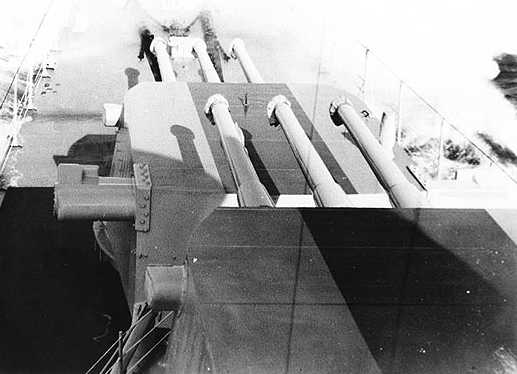
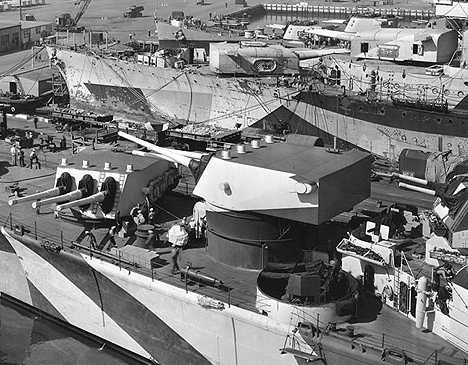
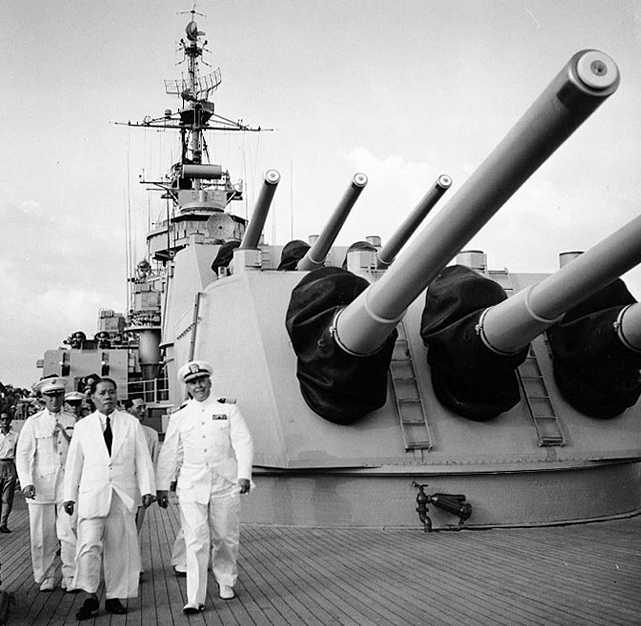
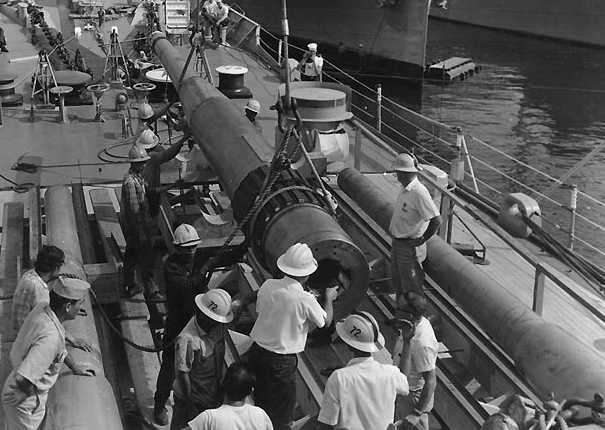
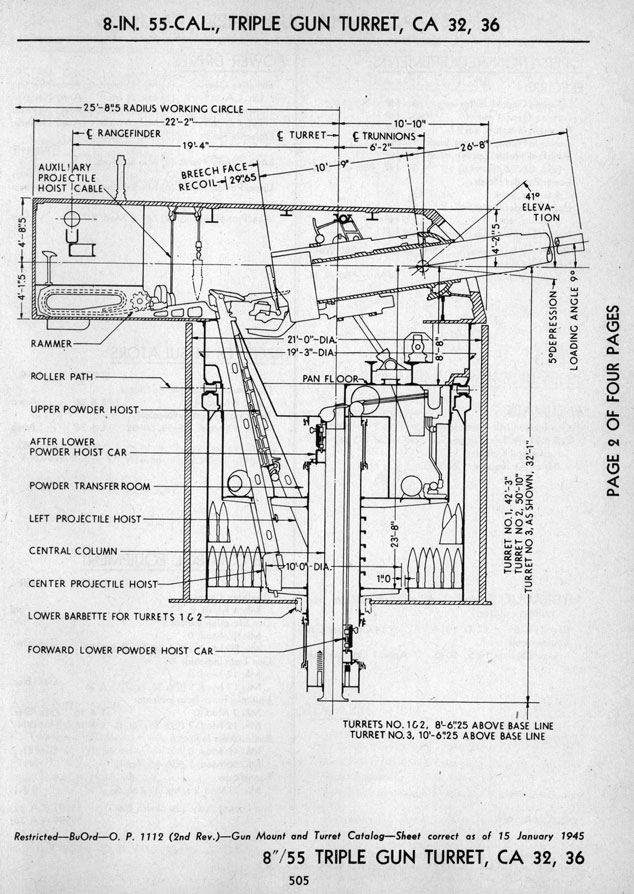
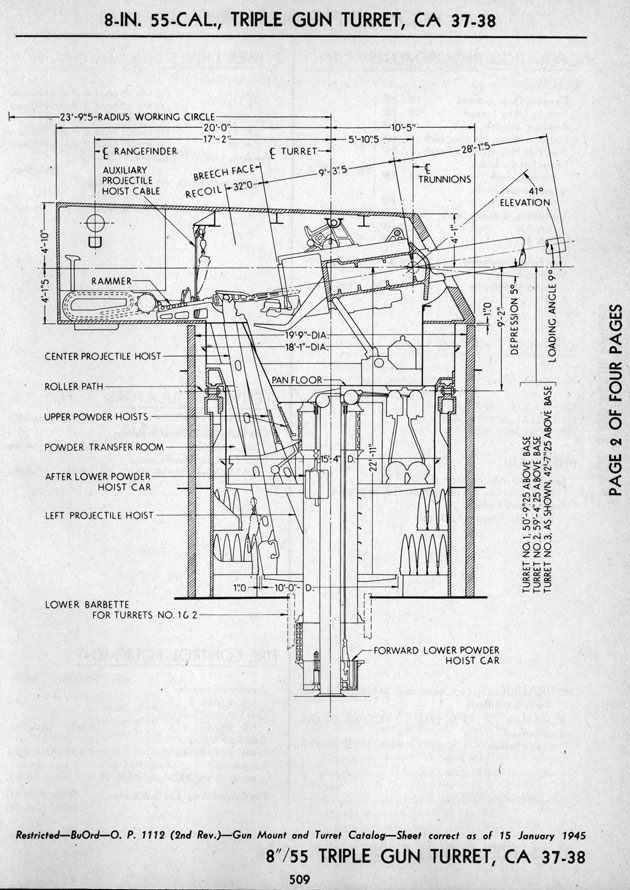
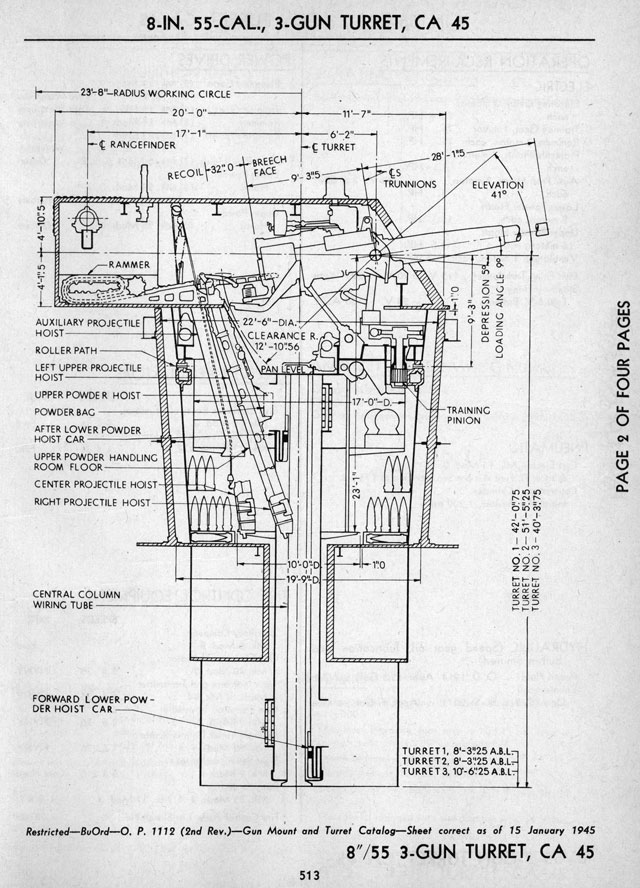

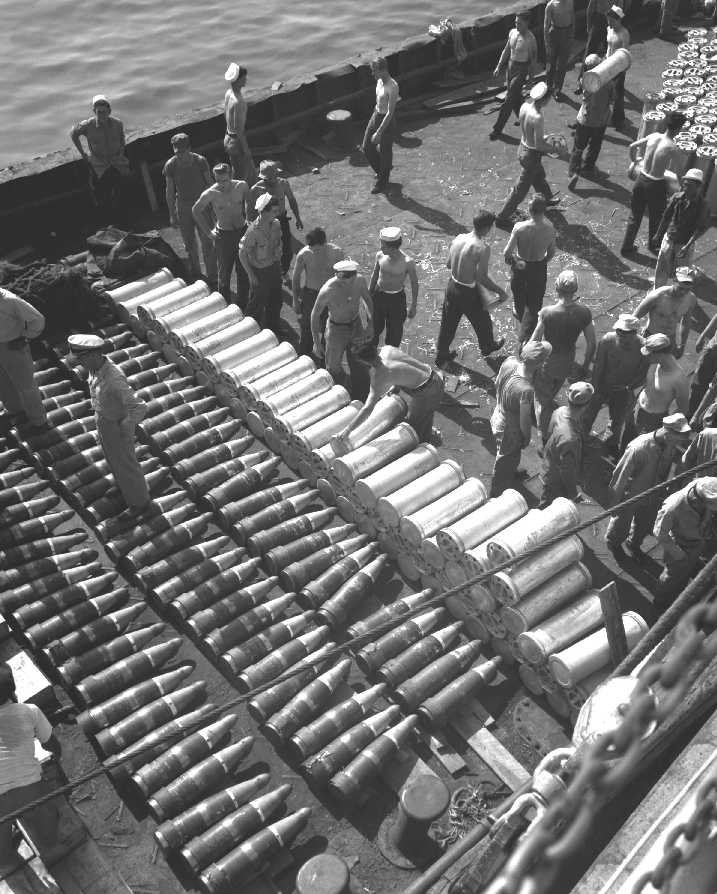

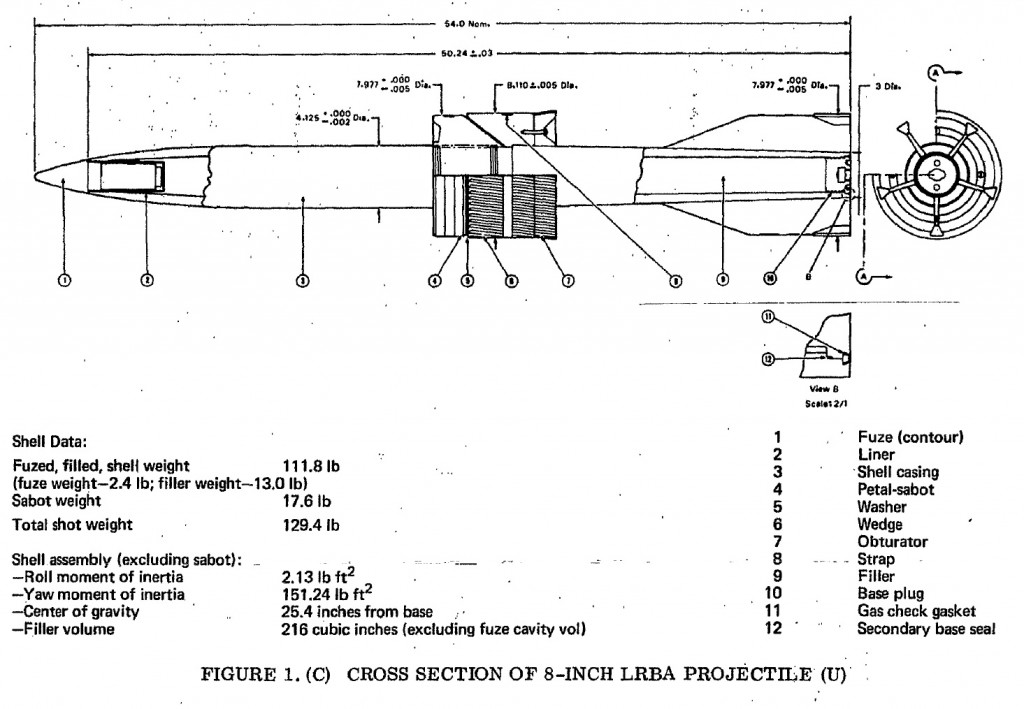
"Naval Weapons of World War Two" by John Campbell
"Powder and Propellants: Energetic Materials at Indian Head, Maryland, 1890-2001 - Second Edition" by Rodney Carlisle
"US Cruisers: An Illustrated Design History" and "US Naval Weapons" both by Norman Friedman
"Round Shot to Rockets: A History of the Washington Navy Yard and the United States Naval Gun Factory" by Taylor Peck
"U.S. Navy Bureau of Ordnance in World War II" by Lt. Cmdr. Buford Rowland, USNR, and Lt. William B. Boyd, USNR
"Cruisers of World War Two" by M.J. Whitley
---
"Naval Ordnance and Gunnery, Volume 2, Fire Control - NavPers 10798-A - 1950" by the Department of Ordnance and Gunnery, U.S. Naval Academy
"United States Naval Guns: Their Marks and Modifications - Ordnance Pamphlet No. 127, 3rd Revision - April 1942" by Bureau of Ordnance (BuOrd), Department of the Navy
"Abridged Range Tables for U.S. Naval Guns - Ordnance Pamphlet No. 1188 - 13 June 1944" by Bureau of Ordnance (BuOrd), Department of the Navy
"U.S. Explosive Ordnance - Ordnance Pamphlet No. 1664 - May 1947" by Bureau of Ordnance (BuOrd), Department of the Navy
---
Gene Slover's Navy Pages
---
Special help from Leo Fischer
07 February 2008 - Benchmark
06 July 2016 - Converted to HTML 5 format
24 April 2018 - Reorganized notes
29 September 2018 - Changed elevation rate of Tuscaloosa
31 December 2018 - Added turret sketches
03 August 2020 - Added note regarding gun replacement
27 September 2020 - Added mounting note about USS Quincy (CA-39) and USS Vincennes (CA-44)
23 February 2022 - Added sketch of LRBA munition
17 June 2022 - Minor additions
10 August 2023 - Revised range tables
